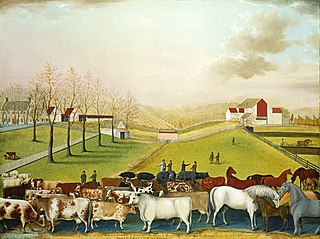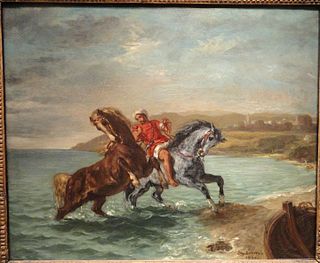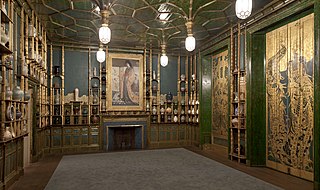 W
WThe Blue Room is a 1901 painting by Pablo Picasso painted during his Blue Period. It was found to have a different painting hidden under it using X-ray technology in 2014 by a group of art historians and scientists from the Phillips Collection in Washington, assisted by scientists from the Cornell University High Energy Synchrotron Source.
 W
WA Boyar Wedding Feast was painted in 1883 by Russian artist Konstantin Makovsky (1839–1915). The painting shows a toast at a wedding feast following a boyar marriage, where the bride and the groom are expected to kiss each other. The bride looks sad and reluctant, while the elderly attendant standing behind her encourages the bride to kiss the groom. The work won a gold medal at the World's Fair held in Antwerp, Belgium in 1885, and is considered to be one of Makovsky's most popular works.
 W
WBulb Fields, also known as Flower Beds in Holland, is an oil painting created by Vincent van Gogh in early 1883. It was donated to the National Gallery of Art in Washington DC in 1983.
 W
WThe Cornell Farm (1848) is an oil on canvas landscape by Edward Hicks. It was acquired by the National Gallery of Art in 1964. The picture depicts the farmland and cattle of Pennsylvanian James Cornell. Hicks's inscription along the bottom of the picture reads: "An Indian summer view of the Farm & Stock OF JAMES C. CORNELL of Northampton Bucks county Pennsylvania. That took the Premium in the Agricultural society, October the 12, 1848 Painted by E. Hicks in the 69th year of his age." The work has been exhibited frequently, with its first display at the Bucks County Bi-Centennial Celebration, Doylestown, Pennsylvania, in 1882.
 W
WHorses Leaving the Sea or Horses Coming Out of the Sea is an 1860 oil on canvas painting by Eugène Delacroix, signed and dated by the artist and now in The Phillips Collection in Washington. Relatively atypical in Delacroix's oeuvre, it shows two horses leaving the sea led by a Moroccan rider, with the town of Tangiers in the background. It was produced for the same art dealer as Arab Horses Fighting in a Stable and is usually regarded as a pair with that work
 W
WLes Joueurs de football, also referred to as Football Players, is a 1912–13 painting by the French artist, theorist and writer Albert Gleizes. The work was exhibited at the Salon des Indépendants, Paris, March–May 1913. September through December 1913 the painting was exhibited at Erster Deutscher Herbstsalon, Berlin. The work was featured at Galeries Dalmau in Barcelona, 29 November – 12 December 1916, Gleizes' first one-person show. The work was again exhibited at Galeries Dalmau 16 October – 6 November 1926. Stylistically Gleizes' Football Players exemplifies the principle of mobile perspective laid out in Du "Cubisme", written by himself and French painter Jean Metzinger. Guillaume Apollinaire wrote about Les Joueurs de football in an article titled "Le Salon des indépendants", published in L'Intransigeant, 18 March 1913, and again in "A travers le Salon des indépendants", published in Montjoie!, Numéro Spécial, 18 March 1913.
 W
WMarcelle Lender was a French singer, dancer and entertainer made famous in paintings by Henri de Toulouse-Lautrec.
 W
WLittle Girl in a Blue Armchair is an 1878 oil painting by the American painter, printmaker, pastelist, and connoisseur Mary Cassatt. It is in the collection of the National Gallery of Art, Washington D.C. Edgar Degas made some changes in the painting.
 W
WLuncheon of the Boating Party is a painting by French impressionist Pierre-Auguste Renoir. Included in the Seventh Impressionist Exhibition in 1882, it was identified as the best painting in the show by three critics. It was purchased from the artist by the dealer-patron Paul Durand-Ruel and bought in 1923 from his son by industrialist Duncan Phillips, who spent a decade in pursuit of the work. It is now in The Phillips Collection in Washington, D.C. It shows a richness of form, a fluidity of brush stroke, and a flickering light.
 W
WMay Night is a 1906 oil painting by American Impressionist Willard Metcalf. It is a nocturne depicting the home of Florence Griswold, now the Florence Griswold Museum in Old Lyme, Connecticut. It was the first contemporary painting purchased by the Corcoran Gallery of Art, and is Metcalf's "most celebrated work."
 W
WMiss Amelia Van Buren or Portrait of Amelia C. Van Buren is a ca. 1891 painting by the American artist Thomas Eakins (1844–1916), now in The Phillips Collection. It depicts Amelia Van Buren, an artist who studied with Eakins, and was called "one of his most gifted pupils." The painting is considered one of Eakins's finest works.
 W
WMountains and Sea is a 1952 painting by American abstract expressionist painter Helen Frankenthaler. Painted when Frankenthaler was 23 years old, Mountains and Sea was her first professionally exhibited work. Though initially panned by critics, it would become her most influential and best known canvas.
 W
WHarmony in Blue and Gold: The Peacock Room is the masterpiece of interior decorative art created by James McNeill Whistler and Thomas Jeckyll, translocated to the Freer Gallery of Art in Washington, DC. Whistler painted the paneled room in a rich and unified palette of brilliant blue-greens with over-glazing and metallic gold leaf. Painted between 1876–77, it now is considered one of the greatest surviving Aesthetic interiors, and best examples of the Anglo-Japanese style.
 W
WA Polish Nobleman is a 1637 painting by Rembrandt depicting a man in a costume of Polish szlachta (nobility). The identity of the subject of the painting is unclear, and has given rise to several different interpretations. The view that the figure's dress is clearly Polish is not universally held and it may have been a self-portrait.
 W
WRose and Silver: The Princess from the Land of Porcelain is a painting by American-born artist James Abbott McNeill Whistler. It was painted between 1863 and 1865. The painting currently hangs above the fireplace in The Peacock Room at the Freer Gallery of Art in Washington, D.C.
 W
WRiver Landscape is a painting by the Italian artist Annibale Carracci which is part of the Samuel H. Kress Collection in the National Gallery of Art, Washington D.C. It was painted in Italy circa 1590 when Carracci and his brother and cousin were pioneering the creation of naturalistic landscape works in which the countryside was depicted for its own sake, rather than as a stylised backdrop to a religious or mythological subject. It can be compared in this respect with his earlier paintings Fishing and Hunting, now both in the Louvre.
 W
WThe Virgin and Child is an oil painting created by the Italian artist Elisabetta Sirani in 1663; she died two years later at the age of 27. The painting is owned by the National Museum of Women in the Arts in Washington, D.C. Its dimensions are 86 by 70 cm.
 W
WVisitation is a 1609–1613 painting of the Visitation by El Greco, now in Dumbarton Oaks in Washington, D.C.